
26 Aug Art of the West
THE TRIPLE B RANCH WRANGLES the diverse spirit of the Wild West. On 25 acres of open grassland just south of Red Lodge, Montana, under the Towne Point is the 5,200-square-foot hideout for the Triple B — named for Bart, Betsy and their boys and families. Initially sketched on a napkin, the Butzers knew, “The key was to find talented local people to help us turn our dream into a reality. Andrew Porth was a local architect who provided us with the foundation we needed.” The design firm of Kibler and Kirch assisted in creating the “experience” the owners wanted. Bart, a retired Target executive, claims, “We wanted the Triple B Ranch to be a place where our families could gather to have a wonderful mountain experience that they might not be able to experience otherwise.”
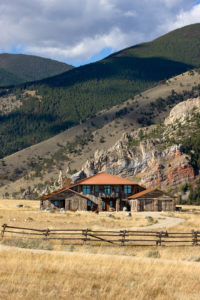 Inspiration for Porth’s architectural renditions came from the Low House designed by McKim, Mead and White in Rhode Island. This ranch-style house, with a central peak, is flanked on each side with symmetrical mirroring spaces, hinting at the configuration of a “literal tent,” explains Porth.
Inspiration for Porth’s architectural renditions came from the Low House designed by McKim, Mead and White in Rhode Island. This ranch-style house, with a central peak, is flanked on each side with symmetrical mirroring spaces, hinting at the configuration of a “literal tent,” explains Porth.
The home, constructed by Timberline Builders, compliments the surrounding landscape. From the exterior which is refashioned with wood from Montana Reclaimed Lumber, as well as Kootenai ledge stone, to the three elk sculptures welded out of patchwork metal pieces by David Herbert McMasters, there is a sense of Mother Nature.
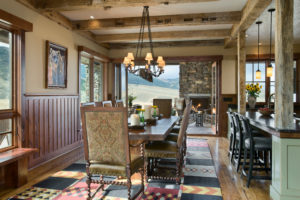 At the front door, a visitor could whisper the secret password through the speakeasy portal. Once in the foyer, focus quickly turns to the large 30-foot span of windows in the towering reclaimed wood-beamed front room. While the view outside is mesmerizing, inside the home’s intricacy is just as engaging, starting with the light fixture in the foyer, of tulip-shaped, Murano-inspired glass shades appear to bloom from elk horns and metal, created by glass artist Ona Magaro, now of Livingston, Montana. A guest may not notice the rust-colored flagstone quarried from Wolf Creek under her feet or realize that the powder room nearby is covered with local tea-stained topographic maps and houses an antique urinal. But she will study the chandelier suspended from the apex of the main room, another illumination crafted by Ona Magaro, ultilizing an old wagon wheel to hang cylindrical blown glass reminiscent of camping lanterns. A circle of blue shades pointing upwards represents sky while red shades dangling downwards are reminders of sunsets and sunrises.
At the front door, a visitor could whisper the secret password through the speakeasy portal. Once in the foyer, focus quickly turns to the large 30-foot span of windows in the towering reclaimed wood-beamed front room. While the view outside is mesmerizing, inside the home’s intricacy is just as engaging, starting with the light fixture in the foyer, of tulip-shaped, Murano-inspired glass shades appear to bloom from elk horns and metal, created by glass artist Ona Magaro, now of Livingston, Montana. A guest may not notice the rust-colored flagstone quarried from Wolf Creek under her feet or realize that the powder room nearby is covered with local tea-stained topographic maps and houses an antique urinal. But she will study the chandelier suspended from the apex of the main room, another illumination crafted by Ona Magaro, ultilizing an old wagon wheel to hang cylindrical blown glass reminiscent of camping lanterns. A circle of blue shades pointing upwards represents sky while red shades dangling downwards are reminders of sunsets and sunrises.
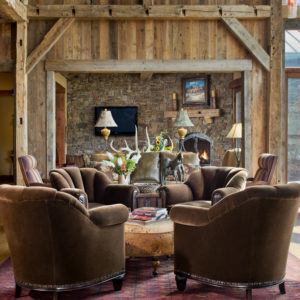 The main level is where everyone gathers. In an alcove to the east of the main room, a fireplace highlights the area for television watching. Close by is the tavern with a billiard table and where the pièce de résistance is the mahogany bar built by Nick Kosorok, fashioned after turn-of-the-century Brunswick bars. It is lined by a back bar that houses an arched silver-antiqued mirror by Custom Glass Signs of San Diego. The bar extends along a copper-lined ledge to the corner of the room and down a sidewall. On the wall hangs a Kato Beer sign that Betsy, an avid antique shopper secured. Bart says, “I was born and raised in Mankato, Minnesota, so this was a very cool find.”
The main level is where everyone gathers. In an alcove to the east of the main room, a fireplace highlights the area for television watching. Close by is the tavern with a billiard table and where the pièce de résistance is the mahogany bar built by Nick Kosorok, fashioned after turn-of-the-century Brunswick bars. It is lined by a back bar that houses an arched silver-antiqued mirror by Custom Glass Signs of San Diego. The bar extends along a copper-lined ledge to the corner of the room and down a sidewall. On the wall hangs a Kato Beer sign that Betsy, an avid antique shopper secured. Bart says, “I was born and raised in Mankato, Minnesota, so this was a very cool find.”
The eating area to the west elegantly interprets a camp mess hall. The rectangular dining room leads straight outside through a wall of bi-folding doors to the stone fireplace fronted with a Bill Moore forged metal screen. In the kitchen, two rustic wood columns reach from the river-washed Nordic black granite central island up to the W.F. Norman metal pressed paneling. Cabinetry, designed by Lee Dungan, in the color of Forest Service green, houses state-of-the-art Viking appliances.
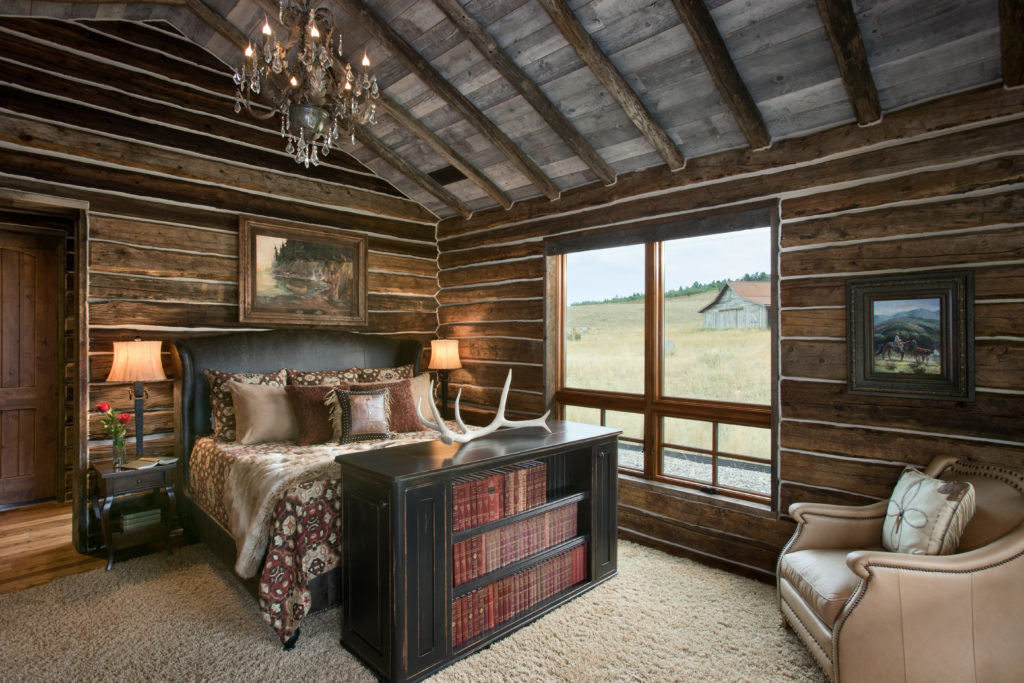
The master bedroom, tucked into the home’s southeast end, is a deconstructed and reconstructed log cabin. Here, the Butzers are far from roughing it with a television that lifts up from a bookcase at the foot of their bed to the copper-footed tub in their bathroom.
Following the prairie grass-themed metal railing created by Dana Dameron up the stairs, are guest bedrooms. The farm-themed room has a barnwood sliding closet door while the “vintage” room has a claw footed bathtub. The “tent” room, found across the open walkway, epitomizes luxury camping. The room has a large antechamber where a back walled area obscures shelves for toys and a children’s play area. The adjoining “tent” room, a favorite of the design team, is lined and draped with canvas.
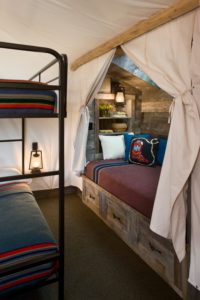 Off the middle of the walkway is the study. This perch offers the best vantage point of the gathering space below and of views all around with the side balcony affording front row seats to morning sunrises.
Off the middle of the walkway is the study. This perch offers the best vantage point of the gathering space below and of views all around with the side balcony affording front row seats to morning sunrises.
The creation of Triple B Ranch in truth required little wrangling. Kibler and Kirch acted as the “facilitators of the dreams,” while Porth states, “It helps to have a client that is open-minded and agreeable,” with the Butzers emphasizing, “The people we worked with were incredible.”




No Comments